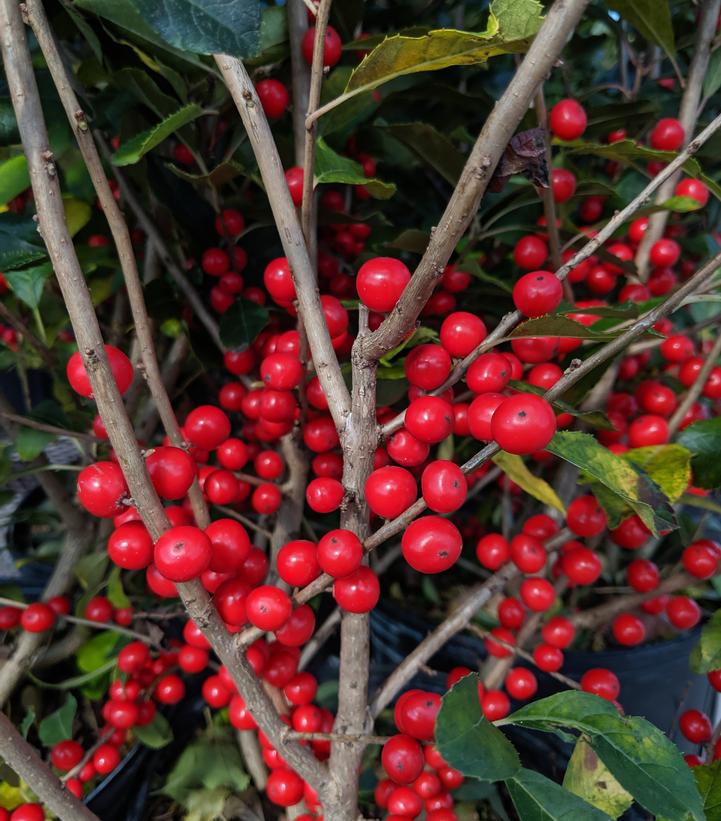Common Name: Red Sprite Winterberry
Bloom Time: Inconspicuous white flowers in late spring to early summer (May–June)
Fruit Time: Bright red berries from fall through winter
USDA Zones: 3–9 (hardy in Southeastern Wisconsin)
Mature Size: 3–5 ft. tall × 3–5 ft. wide
Habit: Compact, rounded deciduous holly
Foliage: Glossy green leaves turning yellow in fall; bare stems in winter highlight berries
Introduction
When the garden landscape turns gray and bare in late fall, Red Sprite Winterberry delivers an unforgettable splash of festive color. This compact shrub is a female cultivar of the native winterberry holly (Ilex verticillata), producing brilliant clusters of red berries that persist well into winter and often through early spring.
For Wisconsin gardeners, this means months of vibrant display against snow and evergreens, along with a critical food source for birds when other food is scarce. Its compact size makes it suitable for small gardens, foundation beds, or grouped plantings for mass berry impact.
Heritage Hill Nursery offers Ilex verticillata ‘Red Sprite’, a top-performing selection for our region:
👉 Shop Red Sprite Winterberry
Origins & Description
Winterberry holly is native to eastern North America, thriving in wetlands, woodland edges, and moist meadows. Unlike evergreen hollies, this species is deciduous, dropping its leaves in autumn to reveal heavy clusters of red fruit on bare stems.
The ‘Red Sprite’ cultivar is one of the most compact and berry-laden selections available. Its fruit is larger than most winterberry varieties, and because of its smaller stature, the berries are displayed prominently, creating an eye-catching winter feature.
As with all hollies, Red Sprite is dioecious, meaning it requires a male pollinator nearby for berry production. The male cultivar ‘Jim Dandy’ is the best pollinator for Red Sprite, flowering at the same time.
Ideal Growing Conditions (Southeast Wisconsin Focus)
-
Light: Full sun to part shade. More sun means heavier fruit set.
-
Soil: Prefers moist, acidic soils rich in organic matter. Tolerates clay soils if drainage is adequate.
-
Moisture: Excellent choice for rain gardens, low spots, or near water features. Requires consistent moisture to thrive.
-
pH: Slightly acidic soils (5.0–6.5) are best; avoid alkaline soils which can cause chlorosis.
-
Hardiness: Extremely cold-hardy, thriving in Wisconsin’s harsh winters.
Planting & Establishment
When to Plant:
-
Spring (April–May): After soil has thawed and dried enough to work.
-
Early Fall (September): Gives roots time to establish before winter.
How to Plant:
-
Dig a hole twice as wide and the same depth as the container.
-
Place the plant level with surrounding soil.
-
Backfill with soil mixed with compost for fertility.
-
Water deeply and apply a 2–3 inch mulch layer, keeping mulch away from the crown.
Pollination Needs:
For berries to form, plant a male pollinator (‘Jim Dandy’) within 50 feet of female shrubs. One male can pollinate multiple females.
Care & Maintenance
-
Watering: Keep soil evenly moist, especially during dry spells. Red Sprite does not tolerate prolonged drought.
-
Fertilization: Apply an acid-loving plant fertilizer (similar to azalea or rhododendron food) in spring.
-
Pruning: Minimal. If needed, prune in late winter before spring growth. Avoid heavy pruning as it may reduce berry set.
-
Pests & Disease: Generally pest-free and not favored by deer, making it an excellent low-maintenance choice.
-
Winter Care: No special protection needed. Berries naturally persist through snow and ice.
Propagation
Winterberry can be propagated by softwood cuttings in summer or by division of suckers. However, for reliable performance, it’s best to purchase named cultivars like Red Sprite and its pollinator Jim Dandy.
Landscape Uses & Companions
-
Winter Interest: Outstanding berry display provides seasonal cheer and curb appeal.
-
Wildlife Gardens: A valuable food source for winter birds such as cedar waxwings and robins.
-
Rain Gardens: Thrives in damp, low-lying areas.
-
Foundation Plantings: Compact form works well near walkways or porches.
-
Companions: Pair with other moisture-loving shrubs like summersweet (Clethra alnifolia), viburnums, or ornamental grasses for layered interest.
Seasonal Calendar (Wisconsin)
-
May–June: Small white flowers bloom; pollination occurs.
-
July–August: Fruit begins to swell and color.
-
September–October: Leaves turn yellow and drop, revealing ripened berries.
-
Winter: Bright red berries persist for months, glowing against snow.
Troubleshooting
-
No Berries: Usually due to lack of a male pollinator or mismatched bloom times. Be sure to plant ‘Jim Dandy’.
-
Yellow Leaves: May indicate alkaline soil. Test soil and amend with sulfur or peat to increase acidity.
-
Sparse Growth: Often caused by drought stress. Maintain consistent moisture.
Ecological & Garden Value
-
Pollinator Support: Flowers provide nectar and pollen for bees in late spring.
-
Bird Value: Berries feed songbirds throughout the winter.
-
Native Heritage: As a North American native, it thrives naturally in Wisconsin’s climate.
-
Seasonal Highlight: One of the few shrubs that shines brightest in the dead of winter.
Ready to Plant?
Add a burst of holiday-red color to your winter garden with Red Sprite Winterberry. Compact, low-maintenance, and wildlife-friendly, it’s a perfect addition to Wisconsin landscapes.

